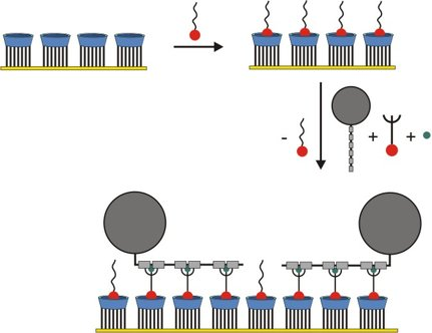“Printboards” for proteins
Attaching proteins to surfaces without them knowing it. This is possible with a new adsorption technique, developed by Ph.D. student Manon Ludden from the University Twente (MESA+/Molecular Nanofabrication. This method allows the development of better protein chips. The research can be found in the authoritative journal “Angewandte Chemie”.
Special chips are going to play a major role in proteomics: the unravelling of the human protein map, just as in the mapping of human-DNA. Proteins, however, do not let them catch as easy as DNA. A molecular printboard with receptors for proteins is not sufficient: proteins undergo non-specific interactions to easily. The protein is bound, but thus not retain its shape and function. To prevent this non-specific binding, Twents researchers put temporally small molecules at the surface: they make the surface “invisible” for proteins.
The protein, however, can bind to, connecting molecules, so-called linkers, which, on their turn, connect to the surface. Because of that, the “small molecules that covered the surface, are pushed away. “In this manner, it is possible to attach more complex-protein systems at surfaces”, says professor Jurriaan Huskens. We can mask the receptors temporarily, and therefore enhance the functionality of the surface. Therefore they are much better applicable as universal platforms for protein-adsorption.
So far, non-specific interactions for protein-protein interactions are suppressed with special measures. Thanks to the small linker molecules, is simplified . The researchers have proven that the method is suitable for instance to attach the frequently used strapavidin-biotin-couple, and for proteins that are functionalized with a so-called histidine tag. The latter is developed in cooperation with the group of Robert Tampé in Frankfurt, and is of utmost importance, since many proteins can be functionalised with such a histidine tag.
The resaerchers are further developing this method for the attachment of antibodies and cells to protein-functionalized surfaces.

Nonspecific protein adsorption is prevented by masking the surface with small molecules. Only proteins that can be connected to special linker molecules will be attachted to the surfcae.
The article Molecular Printboards as a General Platform for Protein Immobilization: A Supramolecular Solution to Nonspecific Adsorption by Manon Ludden, dr. Alart Mulder, prof.dr. Robert Tampé, prof.dr. David N. Reinhoudt en prof dr. Jurriaan Huskens is now online in the Early Edition of Angewandte Chemie.
